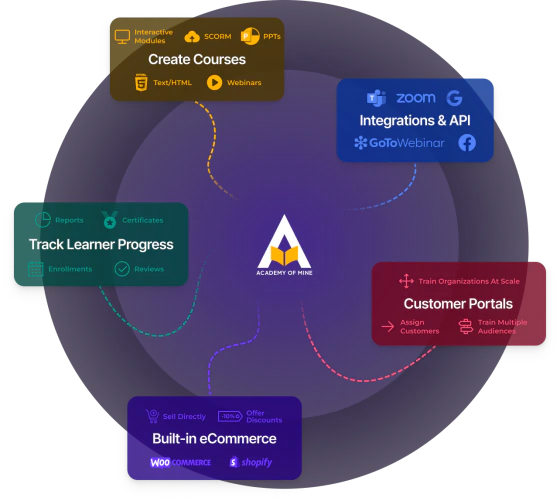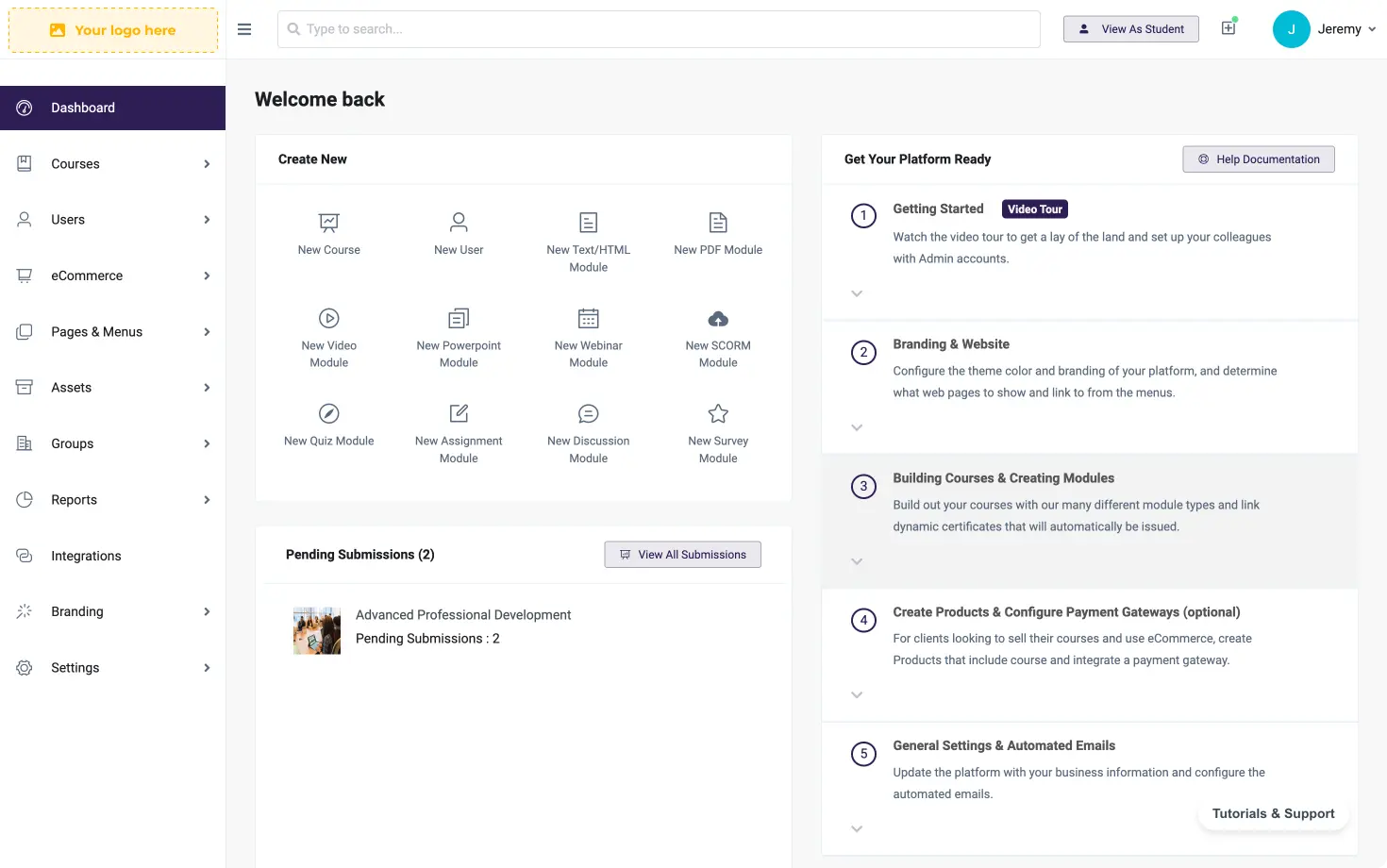Compliance Training, Learning Management System, Professional Training, Safety Training
How To Choose An LMS For Compliance Training

Compliance training helps employees and companies conduct business in accordance with state laws and industry regulations. In this digital world, most employees can train for compliance and earn required certifications by taking online courses and attending webinars. All of this is possible thanks to a tool designed for managing training called a learning management system (LMS). Unfortunately for you, not every LMS is built with the same features you should have while managing compliance training. Additionally, not every LMS provider is supported by a team you can trust and rely on for customer support.
No worries though! In this article, we’re going to talk about what to look for in an LMS for compliance training, and how to select the best LMS for your organization.
Identify the gaps in your current training
Let’s work our way backward, starting with what your current system for managing compliance training is missing. Maybe your biggest issue is not being able to effectively track a user’s progress in a course? Or, maybe your managers can track the performance of users well, but users can’t keep track of their own performance and progress in a course? These questions are just examples of what your current training system might be missing. Sidenote: any LMS worth considering streamlines performance reporting for you.
One easy way to identify specific problems in your current training system is to write down any large inconveniences or setbacks that happened while you were managing courses. Ideally, most if not all of the issues you are dealing with or have dealt with in the past while offering compliance training to businesses and other stakeholders can be solved with your new LMS. Similarly, think of recurring problems that users or admins are experiencing, or processes that take far too long or could be improved ineffectiveness. For example, maybe your current LMS has decent reporting functionality, but you can’t do much when it comes to creating certificates and preventing users from skimming over training material.
If you’re looking for an LMS that lets you design certificates in the platform, track how much time users are spending on activities, and prevent users from skipping ahead in a compliance program–then check us out at Academy Of Mine.
Reasons you should use an LMS for compliance training
Ease of use
If you’re reading this, you’re most likely at a place where your current solution for compliance training is just not cutting it. Let’s side-step for a second. Take Amazon, your favorite online retailer! Amazon is used by so many people in the world because you can find almost any product you would EVER want on Amazon.com and get it shipped to you within 24 hours or less. You need your compliance training program to be just as effective as Amazon’s operation. That way, when professionals in need of compliance training find your program, there’s no doubt in their minds about considering other companies.
Using a reputable LMS that has certain features you need, like performance reporting, single-sign-on, webinar, and course creation tools allows you to attract new customers and keep your current customers satisfied.
Show compliance through digital records
Don’t get us wrong, sharing documents, emails, and PDFs online has its time and place, but running a compliance program at scale is neither that time nor place.
You can simplify the management of compliance training by using an LMS that stores certificates, credits, and other digital records. We recommend going a step further and choosing an LMS that integrates with a digital certificate and badge platforms like CE broker or accredible, so employees can keep track of their accreditations outside of the LMS.
By using an LMS, employees will be able to print out records and provide proof of compliance to employers and other licensing bodies. Additionally, employers will be easily able to check their employees’ and customers’ status of compliance.
Make training more convenient
Whether you’re training your own employees or selling training to other businesses –maintaining compliance in a profession shouldn’t be a complex task. It’s one thing if the actual compliance course is time-consuming and difficult in parts, but it’s another if the process of signing up and completing training is overcomplicated. That’s why your LMS needs to have a native authoring tool, so you as a company can create compliance training that customers can take on-demand.
Your LMS should also be compatible with SCORM files–the eLearning standard for creating courses and interactive training modules. When your LMS is SCORM compatible and has a built-in authoring tool, you will have no problem creating and managing training the way you want. SCORM also allows you to transfer courses from one LMS to another if you ever change your mind about a provider.
Track performance and results
On one hand, compliance training is all about completing courses to stay in business. However, maintaining your employees’ performance while enrolled in a compliance program is also important.
Suppose you have an employee, Jake, taking his yearly IT training, and he just barely makes it through a course to pass his final test.
“Whew, that was close”- Jake says.
Sure, Jake passed, but what happens when he fails to do his job correctly as a result of his poor performance while training?
Whether we are talking about diversity training or technical safety training, it’s important for managers to be able to monitor their learner’s performance while training. This can mean anything from reviewing a student’s assignment submissions to assessing their quiz scores. The point is, that your LMS should help your employees, customers, and partners meet compliance requirements–meanwhile–your training managers can keep track of employees’ performance and results during the process. An LMS for compliance training should also track how long users spend on activities in a course and be able to prevent users from skipping over training materials.
An LMS should be capable of generating helpful reports for you in one place, so your teams and customers are well aware of training performance and insights. In doing so, companies can make improvements to a training program and fast-track their employee development.
Avoid schedule conflicts
Since LMS training can be done virtually on-demand, your organization doesn’t need to rely on coordinating the schedules of various employees, managers, and instructors. A compliance expert can work with your team to develop the course, and then on their own time, managers and employees can take the training. This is also helpful if you work in a company with multiple locations in different time zones: anybody from your team can log in to the LMS and access training courses whenever they have time.
If you’re LMS integrates with your preferred webinar tool (Zoom, Microsoft Teams, etc.) then you can also host webinars to train employees from all around the world in real-time.
5 features of an LMS used for compliance training
The ultimate question is: what are the features your new LMS needs for you to create and manage a successful compliance program? You can find the answer in your current training program’s shortfalls.
For example, if you’re struggling right now with webinars because your current platform doesn’t have integrations, then you need an LMS that integrates with your preferred webinar provider.
Regardless of the LMS you are currently using (or not using) here are some features to consider in your new platform:
1) Integrations
Get yourself an LMS that integrates with other tools your business uses, like Zoom or Microsoft Teams, and HubSpot or Salesforce. Integrations allow your company to connect other software with the LMS, to create all-inclusive compliance programs. The Academy Of Mine LMS for instance integrates with Accredible, so your learners can transfer badges and certifications outside of the LMS for licensing bodies to manage.
2) Certificate builder
Certificate builders are not required, but having one in your LMS used for compliance training allows your company to create certificate templates in the platform and upload certificate designs. Similarly–using this feature–your company is able to customize certificates per course to include any required information and text fields.
3) Groups
Groups, otherwise known as customer portals, allow you to train multiple businesses or separate groups of customers simultaneously. For example, if you’re offering sexual harassment training to multiple businesses in different states, each state’s training adheres to different compliance regulations. With groups, you can create separate training portals for each of your customers to take courses and train their teams.
4) Reporting and Automation
As we mentioned in one of the earlier sections, your LMS needs to have built-in reporting tools, to make life easier for your admins, instructors, and managers overseeing a training program. Another great feature of LMSs is automation. Let’s talk about email notifications to start: sending users emails reminding them of due dates, notifying users when certificates expire and helping users stay engaged in training with various emails.
Using the Academy Of Mine LMS, here are some examples of automatons our system includes:
- Email notifications for users (fully customizable)
- Returning assignment and quiz grades back to learners.
- Auto-submitting a timed quiz or assignment when a timer goes off.
- Reminding professionals when a certification needs to be renewed, and more.
Much of the value in an LMS comes from integrations and automation, both of which help you manage internal and external training programs using a single platform.
5) Single-sign-on
Single-sign-on (SSO) is an authentication setting that allows a user to log in to the LMS with a single username and password. This makes completing compliance more convenient. For example, instead of requiring users to remember “yet another password”, they can just use their work email address and password to log in. Many social media apps use SSO to help users log in to their social media accounts more conveniently.
There are more features to look for in a compliance training LMS, but the 5 features we talked about in this article are must-haves!
Selecting The Right LMS For Compliance Training
You are finally ready. It’s time to select the compliance training LMS of your dreams.
First, your team should look at some of the different LMSs on the market and come up with a budget. We recommend ballparking the budget so that you’re not limiting your options. Meanwhile, you’re also not wasting time looking at LMSs that are out of your price range. Keep in mind the LMS features and characteristics we discussed in this blog while budgeting and comparing options.
Next, we recommend considering only cloud-based LMSs, unless you have a tech team prepared to install software, host the LMS on your own server, and perform manual updates. If that’s not the case, we stand our point. The cherry on top of the cake? Reputable cloud-based LMS companies such as ours, offer demos so that you can create mockup training programs using our platform before putting any money down!
So if you’re ready to step up your compliance training, Get Started today and see for yourselves if our LMS is for you!

